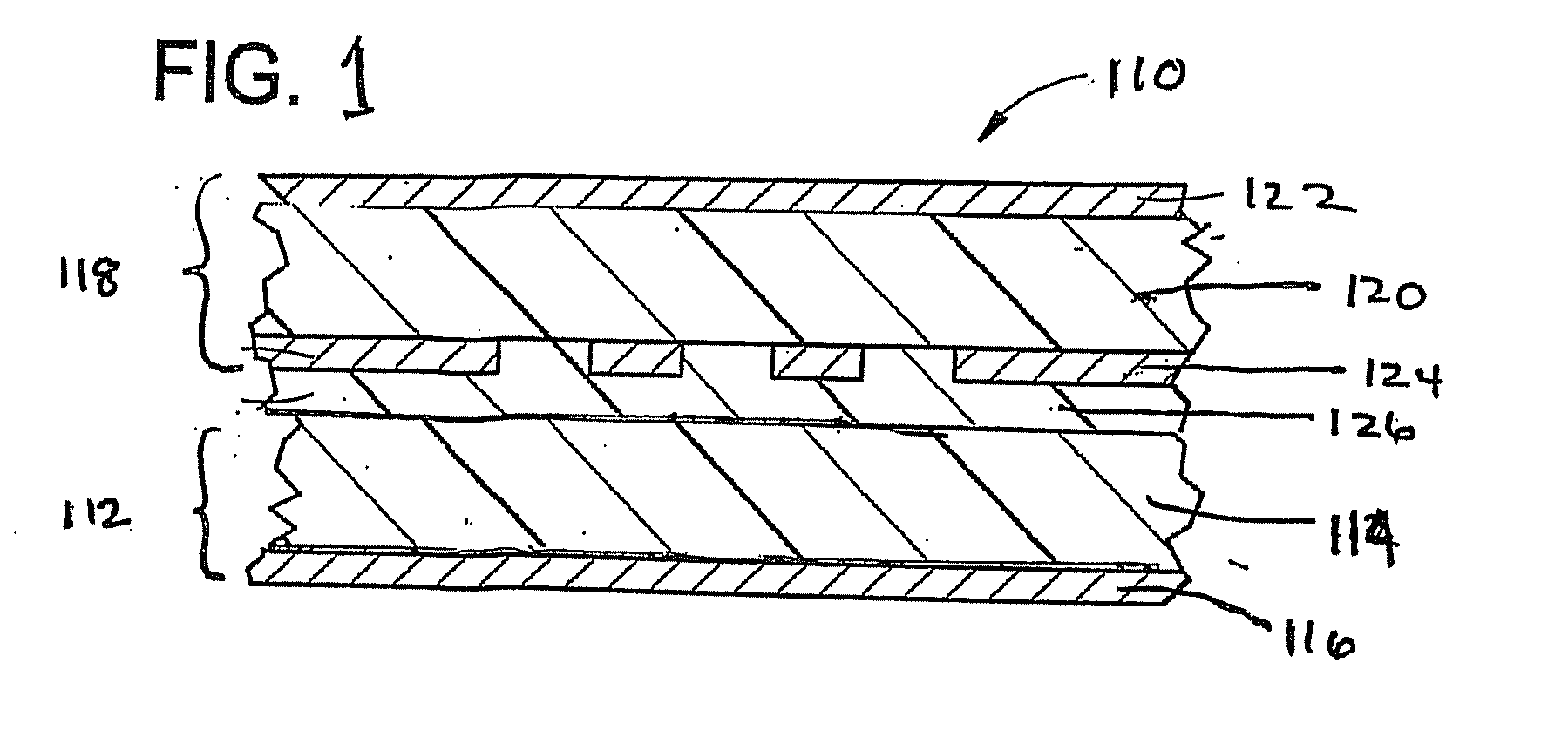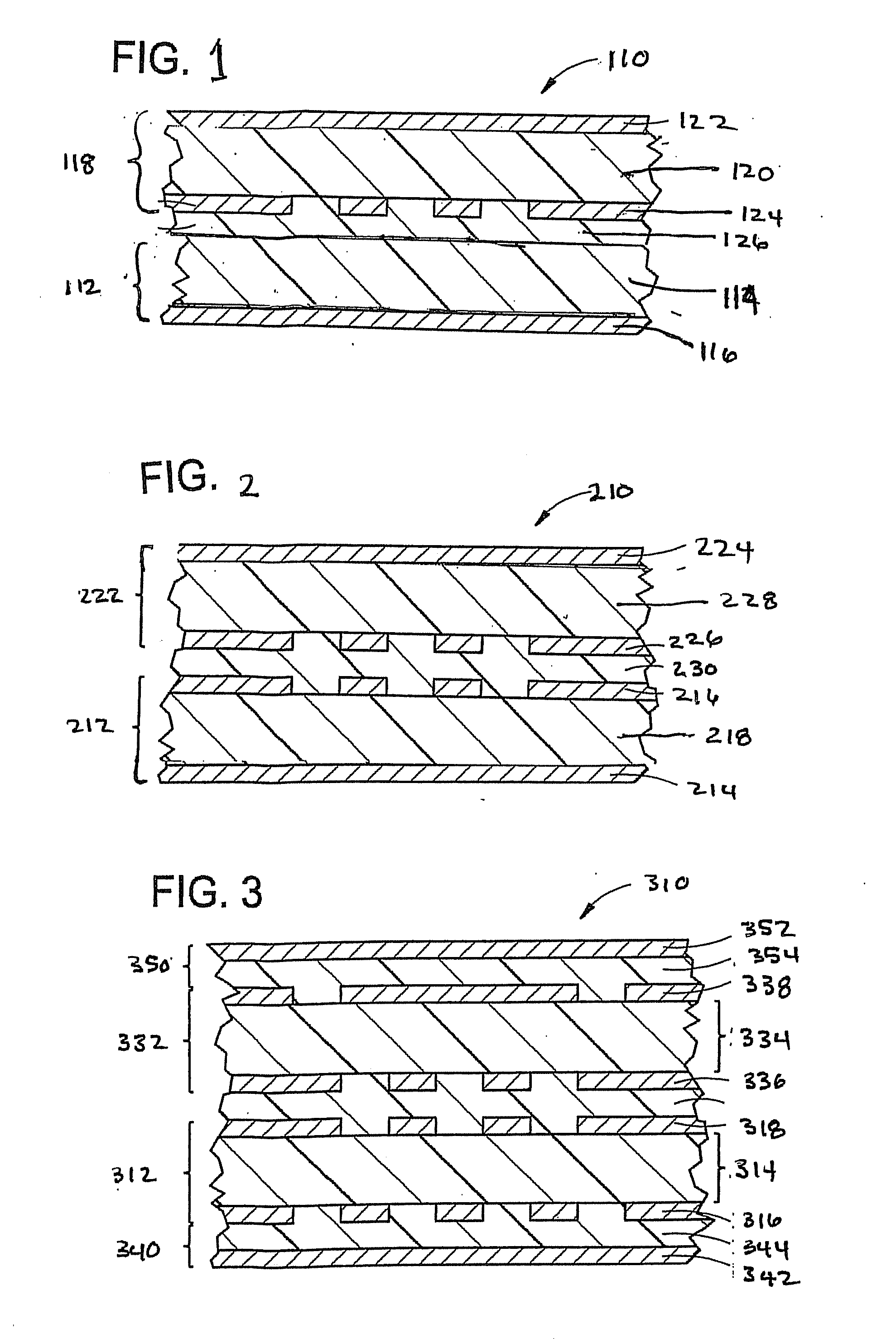Circuit materials, multilayer circuits, and methods of manufacture thereof
- Summary
- Abstract
- Description
- Claims
- Application Information
AI Technical Summary
Benefits of technology
Problems solved by technology
Method used
Image
Examples
example 1
[0088]A 50.8 micrometer (2 mil) thick unfilled PEEK film from Ajedium Film Group, LLC (Newark, Del.) was melt laminated to ½ Oz MQ-VLP copper foil (Mitsui Mining and Smelting, Japan) to make double sided copper clad laminates. The material was laminated at 350° C. and 5.52 MPa (800 psi) for 45 minutes in an oil heated vacuum press. Some properties of these laminates are shown in Table 1.
example 2
[0089]A 50.8 micrometer (2 mil) thick 40 wt % talc polyether ether ketone film, Victrex® PEEK™ 450TL40, from Ajedium Film Group, LLC (Newark, Del.) was melt laminated to ½ Oz MQ-VLP copper foil (Mitsui Mining and Smelting, Japan) to make a double sided copper clad laminate. The material was laminated at 350° C. and 5.52 MPa (800 psi) for 45 minutes in an oil heated vacuum press. Some properties of this non-reinforced PEEK laminate are shown in Table 1. As shown in Table 1, the addition of the talc filler decreases the CTE and results in a significant improvement in the dimensional stability.
TABLE 1Unfilled PEEK40 wt % Talc FilledLaminatePEEK LaminatePropertyMDCMDZMDCMDZMechanical PropertiesDimensional Stability,−0.45−0.84N / A−0.20−0.24N / A% (Method B)Dimensional Stability,−0.37−0.83N / A−0.20−0.30N / A% (Method C)Copper Peel Strength,7.70 (4.4)7.35 (4.2)N / cm (pli)Thermal PropertiesCTE (30° C. to 150° C.),44.457.635.913.419.825.7ppm / ° C.Solder Resistance (60 sec),>330>365° C.Electrical Pro...
example 3
[0090]Two sheets of 50.8 micrometer (2 mil) thick unfilled PEEK film from Ajedium Film Group, LLC (Newark, Del.) were combined with on sheet of 1080 / 767 glass cloth (Hexcel Schwebel) in a hot oil vacuum press to make a melt laminated PEEK prepreg. This prepreg had a thickness of approximately 127 micrometer (5 mil) and was laminated at 350° C., 5.52 MPa (800 psi) for 60 minutes. A 50.8 micrometer (2 mil) PTFE release film was used on either side of the prepreg to prevent the PEEK from adhering to the stainless steel separator plates.
PUM
| Property | Measurement | Unit |
|---|---|---|
| Temperature | aaaaa | aaaaa |
| Temperature | aaaaa | aaaaa |
| Temperature | aaaaa | aaaaa |
Abstract
Description
Claims
Application Information
 Login to View More
Login to View More - R&D
- Intellectual Property
- Life Sciences
- Materials
- Tech Scout
- Unparalleled Data Quality
- Higher Quality Content
- 60% Fewer Hallucinations
Browse by: Latest US Patents, China's latest patents, Technical Efficacy Thesaurus, Application Domain, Technology Topic, Popular Technical Reports.
© 2025 PatSnap. All rights reserved.Legal|Privacy policy|Modern Slavery Act Transparency Statement|Sitemap|About US| Contact US: help@patsnap.com



